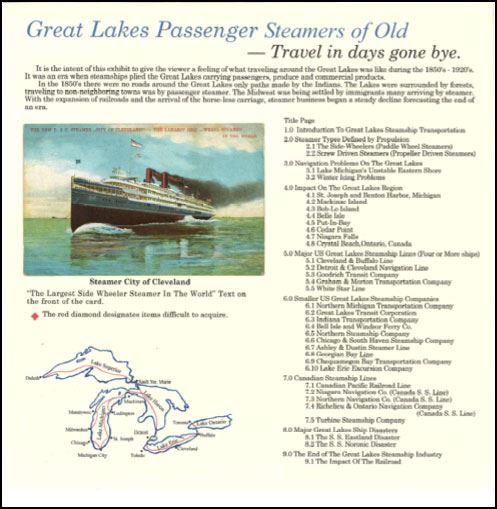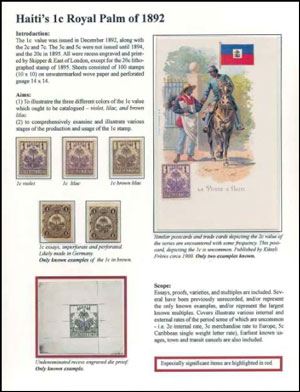- Home
- Resources
- Exhibiting
- The Title Page
Philatelic Exhibiting 101: Title Page
by Robert R. Henak, originally published in Topical Time Regardless whether you exhibit thematics, postal history or postcards, your title page may well be the most important page of your exhibit. This is especially true in the Brave New World of exhibiting ushered in at the national level by the Manual of Judging and Exhibiting (7th edition). Yet far too many exhibitors simply dash off the title page without a second thought. The title page is not simply a piece of paper containing nothing but the title of the exhibit. Rather, as Randy Neil explains in his Philatelic Exhibitors Handbook (Third edition) at 129-30, the title page is best used to explain the exhibit’s significance and to “draw a clear, easily understood roadmap for the judge.” The well-done title page also can note particularly important items in the exhibit, or new discoveries or research by the exhibitor. Depending on how well these purposes are fulfilled, the title page can have a major impact on the ultimate award level at both local and national exhibitions.
Much like the introductory paragraph to an essay, the title page should define – as exactly as possible – what the exhibit will show. A judge or member of the public reading the title page should be able to understand both the scope and content of the exhibit, expecting neither more nor less than the exhibit ultimately delivers. Indeed, the title itself should define the scope of the exhibit. If the title suggests a broader or narrower scope than the exhibit delivers, the award level will suffer accordingly. Using Shakespeare as a title suggests that the exhibit will cover Shakespeare’s life, sonnets and the impact of his works, as well as his plays. On the other hand, one would expect an exhibit titled Shakespeare’s Comedies to be limited to the creation, plot, staging and impact of that subset of his plays. Judges, having limited time to devote to each exhibit, will not appreciate having to search through dense paragraphs of text on the title page to find the statement of purpose and scope of the exhibit. It is therefore a good idea (absent a very good reason not to) to set off your statement of purpose and scope somehow so it is easy to find on the title page. Some exhibitors use a box around the statement of purpose, while others use a bolded header or the like. The following is the current statement of purpose from my Spuds exhibit:
Keep in mind that the statement of purpose is especially important at APS national-level shows judged under the Manual of Judging and Exhibiting (7th edition). A primary impact of that new edition is to abolish the need to shoehorn exhibits into strict classes and categories, giving exhibitors more freedom to choose what and how to exhibit their material. Of course, a necessary consequence of that change is to place on the exhibitor the responsibility to define for the judges and other viewers exactly what it is they intend to show. Without a detailed and comprehensible statement of purpose, the judges are unable to determine how well the exhibitor accomplished what he or she set out to do. The title page and its impact on the exhibit’s treatment scores is discussed in Section 4.3 of the Manual, available online at https://stamps.org/Portals/0/Judging-Manual.pdf. A well-designed title page also will summarize the story of your exhibit. Remember, a quality exhibit has a beginning, a middle and a logical ending. The title page will help explain why your story starts where it does, how the exhibit develops that story and why you have chosen the particular ending. This can be done in words or outline form. Although a plan or outline of the exhibit is required for thematic exhibits, either can be useful in other types of exhibits as well, especially where the exhibit is long and the story is complex. Finally, the title page can briefly explain the exhibit’s significance or highlight important items (or how to find them in the exhibit). Why should anyone care about the postal history of some small Iowa county that did not even exist until shortly before the Civil War? Perhaps because the postal development of that county reflects or represents the similar development of any number of similar counties throughout the Midwest. Why should we care about hoot owls? Maybe because of their impact on the broader environment and sustainability of a given ecosystem. The judge or others viewing the exhibit may not know if you do not tell them and may not be willing to wait until the second row of the third frame to find out. The bold qualification in the preceding paragraph is important. This is not a book, a PhD thesis or even a magazine article you are creating. It is an exhibit for which the judges and others in the viewing audience have little time and much information to try to take in. Again, your job is to make it easy for them to do so.
Of course, there is no rule that you must place a philatelic item on the title page. Anything that draws the viewer into the exhibit’s story or helps to tell it can be placed on the title page, be it a map, a photograph, a picture postcard or – as with a transformational exhibit from the 1980s called Gold Fever – a real gold nugget. In the end, the importance of your title page rests on two factors. First, the title page often is your best – and usually only – chance to catch the attention of the viewing public. Especially where there are a number of exhibits to see, a boring, un- informative title page or uncreative title will lose the audience to your story no matter how impressive the philatelic material actually shown in the rest of the exhibit. Second, with very limited exceptions, the title page alone, from among all the pages of your exhibit, goes to the judges before the show. The title page, sometimes joined by the plan page and a synopsis page (to be discussed in a later article, but which is not actually part of the exhibit), is the only page of your exhibit that the judges must read. Again, a boring or pedestrian title page will lead the jury to expect more of the same at the frames, while a well-done title page will leave the judges enthusiastic to see the rest of the exhibit. For a period of time, the American Association of Philatelic Exhibitors (AAPE) offered an award for the best title page at World Series of Philately (WSP) shows (that is, those shows whose multiframe grand award-winning exhibits compete at the annual Champion of Champions competition at the annual APS Stampshow).You can see some of the winning title pages posted online at www.aape.org/aape_awards_title_page_winners.asp. At the next show you attend, take the time to read several of the title pages of the exhibits presented. Indeed, reviewing other exhibits is a great way to get new ideas for your own exhibits, regardless of the level of the show and the overall quality of the exhibits. See what you like about them and what you decide just does not work for you. Then feel free to incorporate the ideas you like into your own exhibit. |

 Given the importance of the title page, for experienced exhibitors it is often the first page written and the last one finalized. It is quite common for an exhibitor to revise the title page multiple times during the process of designing and mounting an exhibit.
Given the importance of the title page, for experienced exhibitors it is often the first page written and the last one finalized. It is quite common for an exhibitor to revise the title page multiple times during the process of designing and mounting an exhibit. As for important items, some exhibitors choose to identify the most important items or groups of items right up front on the title page. While not required, such a tactic reduces the risk that the judge and other viewers will miss your best material. Indeed, there was a time when exhibitors would place one of the very best items on the title page as a kind of teaser of things to come. While the exhibitor should not be docked for such a move today, the consensus currently seems to be that the top pieces should be included where they logically fit in the body of the exhibit and that the title page should be reserved for either an item appropriate to the beginning of the story told by the exhibit or an item representative of the exhibit storyline as a whole.
As for important items, some exhibitors choose to identify the most important items or groups of items right up front on the title page. While not required, such a tactic reduces the risk that the judge and other viewers will miss your best material. Indeed, there was a time when exhibitors would place one of the very best items on the title page as a kind of teaser of things to come. While the exhibitor should not be docked for such a move today, the consensus currently seems to be that the top pieces should be included where they logically fit in the body of the exhibit and that the title page should be reserved for either an item appropriate to the beginning of the story told by the exhibit or an item representative of the exhibit storyline as a whole.